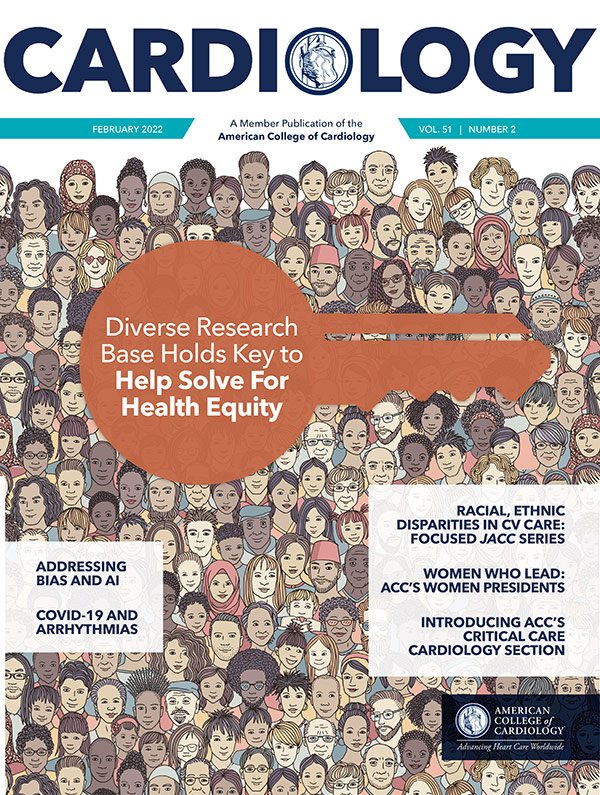Cover Story | Diverse Research Base Holds Key to Help Solve For Health Equity

The disparate impact of COVID-19 along with widely publicized incidents of violence against members of certain minority groups have drawn attention to longstanding, deep and persistent health inequities faced by many people in the U.S.
While efforts to improve health equity are the focus for organizations like the ACC, patient advocacy groups and even some lawmakers, payers and industry groups, real and long-term change won't happen overnight. In the meantime, diversity in clinical trials is not optimal, outcomes for women and minorities continue to lag, and diversity in the existing workforce is lacking, despite some incremental progress.
What is needed to truly solve for health equity? One answer lies in the need for reliable and trusted research and data.
Cardiology spoke with leaders in the field to explore some of the challenges to conducting high-quality research and opportunities to overcome these barriers to derive actionable solutions that optimize care and outcomes for all patients.
Mandate Clinical Trial Diversity, Don't Suggest It
The foundation for today's standard of care treatment of cardiovascular disease is based on findings from clinical trials that fail to fully represent elderly patients, minority populations and women.1 "This is something that keeps people like myself up at night," says Quinn Capers IV, MD, FACC, chair of ACC's Diversity and Inclusion Committee. As an example, Black people make up about 13% of the US population but make up less than 5% of the racial demographics in most cardiovascular research trials. Follow this through to clinical practice guidelines and the impact of this is clearly seen.
The current heart failure guideline from ACC/American Heart Association/Heart Failure Society of America published in 2013, with focused updates in 2016 and 2017, has just two examples where race/ethnicity is the focus of a specific treatment difference: one relates to the use of hydralazine-isosorbide dinitrate in NYHA class III-IV heart failure with reduced ejection fraction and the second to the relative frequency of aTTR cardiac amyloidosis in Black patients.2
The U.S. Food and Drug Administration (FDA) has attempted several times to improve the representation of women and minorities in clinical trials, with the most recent guidance issued in November 2020 specifically addressing eligibility criteria, enrollment practices and trial designs.

Quinn Capers IV, MD, FACC
"The guidance provides the agency's current thinking on steps sponsors can take to broaden eligibility criteria in clinical trials through inclusive trial practices, trial designs and methodological approaches," says the FDA's Rear Admiral Richardae Araojo, PharmD, associate commissioner for Minority Health, Office of Minority Health and Health Equity.
"The guidance also provides recommendations for how sponsors can increase enrollment of underrepresented populations in their clinical trials and improve recruitment so trial participants will better reflect the population most likely to use the drug, if the drug is approved, while maintaining safety and effectiveness standards," she adds.
However, some think the problem with the FDA's guidance is that it stops short of mandating diversity.
"I think in the end, there will need to be a regulatory solution, both a carrot and a stick," says Paul L. Douglass, MD, MACC, chair of ACC's Health Equity Task Force. He suggests, for example, that research teams that meet their recruitment goals be rewarded in some fashion, while those that don't are penalized. "We need to be incremental in our approach, but clearly it's not going to just happen because we say it should happen," Douglass says.
Moving Clinical Research to Communities
Another opportunity to improve health equity research is to move studies away from academic centers and into the community.
"I think the potential for reducing disparities exists, but in order to do it, we need to have everyone contributing," says Douglass.
Araojo agrees, noting that the FDA remains committed and continues to work to increase the participation of racial and ethnic minorities and other diverse populations in clinical trials. The development and long-term sustainability of an infrastructure that brings clinical research into the community will help reap equity rewards to diverse populations.
"A multisector approach, partnerships, engaging patients and providers, and sharing of best practices are all opportunities to continue to advance racial and ethnic minority inclusion in clinical trials," she says.
Early collaborative efforts have shown that academic-community partnerships are possible and do work. For example, the Johns Hopkins Clinical Research Network (JHCRN) – founded in 2010 – has spearheaded the drive towards integrating clinical research with community-based health care delivery systems by creating collaborations that link its academic center with a diverse network of regional health systems, giving researchers access to more than 5 million potential research participants. Johns Hopkins manages much of the heavy lifting, like contract negotiations, budgets, internal review board approvals and regulatory reporting, while affiliate sites can decide which trials they want to participate in and even get help developing ideas for new studies.

Paul L. Douglass, MD, MACC
To be clear, diversifying the research participant population is less about revealing unknown biological differences in response to treatment, and more about ensuring generalizability. One other benefit, says Robert O. Roswell, MD, FACC, associate dean for Diversity, Equity and Inclusion at Zucker School of Medicine at Hofstra/Northwell in New York, is that clinical trial participation often cancels out certain negative social determinants of health, such as health care access, which can be very revealing in understanding disparate patient outcomes.
"We know that clinical trials don't really mirror real life. But in the case of social determinants of health, this could be a good thing and helps us better understand what's standing in the way of progress," he says. In addition to broadening the patient base, expanding research into the community can increase the diversity among those coordinating the trials and those doing the research studies.
"More minority principal investigators, and more community clinicians participating in clinical research will lead to enrolling more individuals from their communities," says Capers. "We've seen that when we have greater diversity among researchers, they are more successful at recruiting more diverse patients into the study and do a better job with retention of these individuals."
Diversity in trial coordinators is often overlooked, but also essential says Capers. "The research coordinators are where the rubber meets the road – they're the ones who sit down with the patients, explain the study, get informed consent, keep up with the patients. We need that group of people to be more diverse, be more culturally competent and culturally aware," he suggests.
A team at Vanderbilt University Medical Center has offered a creative solution to this.2 They developed an eight-hour massive open online course to help study personnel gain knowledge and skills to enhance the recruitment of minorities. Preliminary evidence is promising, with post-test respondents (n=14) indicating the course improved their professional knowledge and the likelihood they would make changes to their recruitment and retention practices.
Strategizing and the Power of Neighborhoods
Roswell would like to see more population-based research in cardiology, similar to a study he recently published that looked at the out-of-hospital sudden death (OHSD) during the first COVID-19 wave in New York City (NYC), looking not at individuals but at zip codes.3
The amount of variation seen between different zip codes was hardly inconsequential. Overall, there was a 4.97-fold increase in the incidence of OHSD in the early part of the pandemic surge compared with the same time period in 2019, but this increase ranged across NYC zip codes from a 0.25-fold increase to a 19.5-fold increase.
Robert O. Roswell, MD, FACC
"When we focused on neighborhoods and zip codes, rather than just counting individuals of different races and ethnic groups, and included socioeconomic and sociodemographic variables, two factors at the zip code level were the mostly likely driver of the increase in OHSD: less than a high school education and Black race," reports Roswell.
"I think we've gotten better at talking about structural racism and the impact that has on health equity. Now we need to move further and look at strategy to see how we can impact some of these modifiable factors that impact individuals and communities," Roswell adds.
The Groundwater Approach, described in a white paper from the Racial Equity Institute, tries to help practitioners at all levels internalize the impact of a racially structured society on inequity. Such an approach moves away from attributing disparate outcomes to individual factors or local systems of care, and recognizing deeper causes.
The metaphor is based on the idea that if one fish in the pond dies, the cause might be the fish. Even if two fish die, those fish might be to blame, or perhaps it's the pond. But if half the fish in all the ponds across the region die, it's time to consider the groundwater and recognize that "the underlying structure from which the fish seek life has failed."
"So, if we look at the community as the groundwater, then we can start to think about groundwater solutions," says Roswell.
Science Can Change the Groundwater
Driving Change
Since it was first formed in 2017, the ACC's Diversity and Inclusion Task Force has been a powerful and effective change agent in the College and in the profession. Recognizing the challenge as more a marathon than a sprint, the Task Force was transitioned to a standing committee in March 2021.
Beyond the development of diversity and inclusion principles, the Committee has conducted and published research identifying and addressing barriers in underrepresented communities, increased leadership opportunities for minority members and taken on the issue of equitable compensation. Visit ACC.org/Diversity to learn more about the Committee's work and access clinician and patient resources.
"Scientists and scientific journals have the opportunity to facilitate best practices and ultimately impact racial and ethnic disparities," write Khadijah Breathett, MD, MS, FACC, in a recent editorial on this topic.4 In other words, deliberate action to methodically examine structural factors when studying racial and ethnic disparities can improve the groundwater and improve equity.
Breathett and colleagues outline several best practices for authors conducting and reporting their research. Their advice ranges from forming diverse and inclusive study teams to explicitly describing the rationale and methodology for including diverse patient populations, including a description of how race and ethnicity were analyzed in statistical models.
It's not something that can be left as an afterthought, notes Capers. "If halfway through enrollment you realize you only have five Hispanics in the whole study, it's too late. It's something that has to be built in from the beginning," he says.

Robert O. Roswell, MD, FACC
Authors should also contextualize their discussions of results by identifying contributing factors and strategies for eliminating barriers to more equitable outcomes. "To be most effective, we have realized that disparities research requires reframing all phases of the research protocol to ultimately achieve cardiovascular health equity," write Breathett, et al.
At the end of the day, problems can't be solved if they are not understood. Health equity cannot be achieved until all parts of the health ecosystem fully understand and accommodate for the differences between patients. Democratizing clinical research such that the evidence-base from which clinical practice is guided is inclusive of racial and ethnic differences is an important initial step.
Douglass notes, "We need more trials and better trials to get to a degree of precision medicine where we'll be able to understand how an individual responds to a particular pharmaceutical or device. Ultimately, I think we'll see that the influence of race on health outcomes is small. The factors that will be a greater determinant of how a person fares are whether or not there is transportation back and forth to the doctor, whether there is access to quality health care, whether an environment has been built that encourages health and provides an opportunity for leisure activities and exercise, and whether a person lives in a food desert. All of these things will be much more important than ethnicity or racial background."

Paul L. Douglass, MD, MACC
Workforce Diversity Improves Competency
The goal of workforce diversity is not to have 100% concordance between clinicians and patients. "Having only women treat women and Black people treat Black people would be a sad state of affairs, and not what we want at all," says Capers.
That's not to minimize the benefit of having a clinician who comes from a similar background and the deep understanding and rapport that can happen, he adds. "It can be a wonderful thing when the clinician and patient come from the same background. The care is very patient-centric and culturally appropriate. But we're not saying that all care should be race- or ethnicity-concordant."
What is clear is that enhanced diversity improves overall quality of care through a number of avenues, including by increasing cultural competence in patient-provider relationships, and by increasing the breadth and scope of research with a broader range of perspectives.6
Blacks represent about 13.4% of the U.S. population, but less than 3% of the cardiologist workforce.7 Hispanics are 18.5% of the population, but only 4.2% of the cardiology workforce. American Indians or Alaska Natives? Their percentage of the U.S. population and adult cardiology workforce are 1.3% and 0.2%, respectively.
The good news is that cardiology's workforce diversity is gradually improving. The total number of cardiology trainees self-reporting their race/ethnicity as Black, Hispanic, American Indian, Native Alaskan, and Native Pacific Islander increased from 9.6% in 2009 to 11.6% in 2018, an absolute increase of 110 fellows.8
"I think the ultimate goal of having more diversity in the workforce is to expand minds," says Roswell. "If I train and work with a wide range of men and women from different communities and cultures, my ability to see things from different perspectives, solve difficult problems and see my blind spots will all be improved."
An important downstream effect of greater diversity is improved trust from the community, notes Roswell, something else that has also been shown to improve health outcomes.
"It doesn't have to be their particular doctor, but if patients see that Black people, Hispanic people and women are represented in the hospital or in the cardiology community, they feel more comfortable and trusting of the process," he notes.
Overcoming Barriers to Clinician Engagement in Clinical Research
There are multiple barriers to wider clinician engagement in clinical research, starting with a simple lack of awareness of current research efforts, note FDA's Rear Admiral Araojo and colleagues in a recent New England Journal of Medicine Perspective piece.9
"Additional barriers are lack of time and compensation for discussing trial participation with patients, failure to see clinical trials as an integral part of the care continuum, concerns that participation may interfere with established patient-clinician relationships, and lack of recognition for referring patients to trials," write the FDA team, led by Janet Woodcock, MD, the acting commissioner.
In addition to the FDA's work, the ACC has been working over the last several years to increase the engagement of women and other underrepresented groups in clinical trial research through the Clinical Trials Research: Upping Your Game program. The latest cohort kicked off their year-long journey in late January. Click here to learn more about the program.
Additionally, the College has been working with other stakeholders, including its Industry Advisory Forum partners, payers and patient groups, to identify opportunities to work together to increase diversity among both clinical trial researchers and participants. The ACC's Industry Advisory Forum this past December was dedicated entirely to the topic of health equity (see the January issue of Cardiology), while a May 2020 Heart House Roundtable explored the future of cardiovascular research in light of the COVID-19 pandemic. Click here for an overview published in the Journal of the American College of Cardiology.
ACC's CardioSmart initiative also has an entire section on clinical trial patient education, including a helpful infographic. Access these resources at CardioSmart.org/ClinicalTrials.
It's Racism, Not Money or Genetics
It is important to avoid generalized genetic explanations for racial and ethnic disparities. At best, they are inaccurate. At worst, generalized genetic explanations are used to excuse racial bias.
"The disparities we see in health outcomes have more to do with race as a social construct than race as a genetic construct. This means that people of certain ethnic backgrounds, people of a certain gender, people of certain sexual orientation, people of certain socioeconomic groups, are disparate in their abilities to achieve optimal health. It has very little to do with biology," Douglass tells Cardiology.
Capers adds, "It's possible there are some small genetic differences. Certainly we've seen some differences between Blacks and others in how they respond to treatments, like ACE inhibitors. But we're not going to one day find that Blacks and other disadvantaged populations have some gene that puts them at markedly greater risk for high blood pressure, heart attack and stroke, and Whites don't have that gene."
"What we need to wrap our heads around – and this is slowly happening – is that it's living in a place where you feel constantly oppressed, where you need to be hypervigilant, and you feel you're being watched and reacted to unfairly, that's driving high blood pressure and early myocardial infarctions far more than any genetic or epigenetic differences," he adds.
It's also important to avoid the overly simplistic suggestion that it's all about money. "We sometimes default to thinking that Blacks have worse health outcomes because they are more likely to be poor. We know that socioeconomic status is a risk factor for poor health and health outcomes," says Capers. "Money helps with many things, but it doesn't fix everything. For example, middle-class Blacks and Hispanics still have worse outcomes than middle-class Whites."
Also, health disparities are not the same as health differences. "Men and women have a different risk for breast cancer – that's not a disparity. Black Americans also have a specific, genetically-based risk of transthyretin amyloidosis – that's also not a disparity. It's biological and not modifiable," Roswell explains.
"But Black men having a much higher risk of hypertension is a disparity and it's something we need to realize we can modify by modifying the environment, the treatment, and so on," adds Roswell.
As another example, a recent study in Nature pooled findings from 201 genome-wide association studies (GWAS) in 35 countries involving people from five ancestral groups (African, East Asian, European, Hispanic and South Asian), and found that including data from people of diverse ancestries substantially improved researchers' ability to identify genes controlling cholesterol levels and to predict levels across all ancestries.5
Co-senior author Themistocles Assimes, MD, PhD, at Stanford University School of Medicine, spoke with Cardiology about the study, and its application to clinical practice and reducing inequity.
"There is a slew of things that contribute to health inequities. In general, the biology of disease is not thought to be different between different populations," says Assimes.
"This doesn't mean there aren't some very subtle differences that might lead one group to be more predisposed to a disease or condition than another group because they've inherited, as a population, a genetic variation in their DNA code. In this [GWAS] era we're basically trying to dissect the genetics of modestly or moderately inheritable traits."
The most direct application of this new information is polygenic risk scores, which are increasingly being used to predict the risk of common diseases. "Developing and using risk scores that are derived based on only one population risks exacerbating health inequities, because it doesn't work as well in other populations," notes Assimes.
HF Trials Show the Way Forward
Heart failure (HF) is one area of cardiovascular medicine where there exists a growing foundation of clinical trial evidence supporting the important role of race/ethnicity and gender in understanding disparities in diagnosis, care and outcomes. The hope is that this evidence will facilitate efforts to close the gaps, but also will serve as guidance for other areas in cardiovascular medicine.
Several recent trials have highlighted disparities in heart failure burden, management and outcomes. Several more have highlighted how race and gender influence decision-making.
Here are some quick takeaways from some of the bigger trials published in recent years.
- Despite their disproportionately higher risk of HF, Blacks have been underrepresented in clinical trials of HF therapies. From 25 trials, only 5.9% of participants were Black. Outcomes by race were reported in only 12 of 25 trials.1
- Interestingly, trials enrolling from North America exclusively had more proportional representation, enrolling an average of 31.6% Black participants.2
- Blacks represented only 5.1% of the study population of the PARADIGM-HF trial but had a markedly higher rate of angioedema compared with non-Blacks (1.79% vs. 0.44%). Because of inadequate representation, it is difficult to conclude whether this is a true adverse effect or an incidental finding.3
- Although primary ICU care by a cardiologist is associated with higher in-hospital survival during a HF hospitalization irrespective of race, Blacks were less likely than Whites to receive it.4
- Clinicians show racial bias in decision-making for advanced HF therapies, limiting Black American's odds of receiving a heart transplant. When the decisions were made by individuals via a survey, no bias was seen. But when groups discussed the cases, a modest degree of bias was apparent. The researchers note that most advance therapy decisions are made in group settings.5
- Women with HF and reduced ejection fraction are less likely than men to receive appropriate ICD shocks, have similar survival benefit with left ventricular assist device but with a higher risk of neurologic adverse events, and have worse survival while awaiting heart transplantation but slightly better survival than men after transplantation.6
- States that adopted Medicaid expansion early (by January 2014), had a significant 30% increase in the rate of heart transplant listings for African Americans.7
- HF deaths have been positively impacted by Medicaid expansion in a study that looked at states that did and did not expand coverage.8
And for the health policy wonks out there, some evidence of what works:
References
- Sullivan LT, Randolph T, Merrill P, et al. Representation of Black patients in randomized clinical trials of heart failure with reduced ejection fraction. Am Heart J 2018;197:43-52.
- Azam TU, Colvin MM. Representation of Black patients in heart failure clinical trials. Curr Opin Cardiol 2021;36:329-34.
- Anaba U, Ishola A, Alabre A, et al. Diversity in modern heart failure trials: Where are we, and where are we going. Int J Cardiol 2021;Dec. 15:[Epub ahead of print].
- Breathett K, Liu WG, Allen LA, et al. African-Americans are less likely to receive care by a cardiologist during an intensive care unit admission for heart failure. JACC Heart Fail 2018;6:413-20.
- Breathett K, Yee E, Pool N, et al. Does race influence decision making for advanced heart failure therapies? J Am Heart Assoc 2019;8:e013592.
- Hsich EM. Sex Differences in advanced heart failure therapies. Circulation 2019;139:1080-93.
- Breathett K, Allen LA, Helmkamp L, et al. The Affordable Care Act Medicaid expansion correlated with increased heart transplant listings in African-Americans but not Hispanics or Caucasians. JACC Heart Fail 2017;5:136-147.
- Khan SS, Lloyd-Jones DM, Carnethon M, Pool LR. Medicaid expansion and state-level differences in premature cardiovascular mortality by subtype, 2010-2017. Hypertens 2020;76:e37-e38.
- Lewsey SC, Breathett K. Racial and ethnic disparities in heart failure: current state and future directions. Curr Opin Cardiol 2021;36:320-8.
References
- Ortega RF, Yancy CW, Mehran R, Batchelor W. Overcoming lack of diversity in cardiovascular clinical trials. Circulation 2019; 140:1690-2.
- Piña IL, Jimenez S, Lewis EF, et al. Race and ethnicity in heart failure: JACC focus seminar 8/9. J Am Coll Cardiol 2021;78:2589-98.
- Kusnoor SV, Villalta-Gil V, Michaels M, et al. Design and implementation of a massive open online course on enhancing the recruitment of minorities in clinical trials – Faster Together. BMC Med Res Methodol 2021;21:44.
- Mountantonakis SE, Epstein LM, Coleman K, et al. The association of structural inequities and race with out-of-hospital sudden death during the COVID-19 pandemic. Circ Arrhythm Electrophysiol 2021;14:e009646.
- Breathett K, Spatz ES, Kramer DB, et al. The groundwater of racial and ethnic disparities research. Circulation Cardiovasc Qual Outcomes 2021; 14:e007868.
- Graham SE, Clarke SL, Wu KHH, et al. The power of genetic diversity in genome-wide association studies of lipids. Nature 2021;Dec. 9:[Epub ahead of print].
- Capers Q, Johnson A, Berlacher K, Douglas PS. The urgent and ongoing need for diversity, inclusion, and equity in the cardiology workforce in the United States. J Am Heart Assoc 2021;10(6):e018893.
- Johnson AE, Talabi MB, Bonifacino E, et al. Racial diversity among American cardiologists: Implications for the past, present, and future. Circulation 2021;143:2395-2405.
- Santhosh L, Babik JM. Trends in racial and ethnic diversity in internal medicine subspecialty fellowships from 2006 to 2018. JAMA Netw Open 2020;3(2):e1920482.
- Woodcock J, Araojo R, Thompson T, Puckrein GA. Integrating research into community practice - toward increased diversity in clinical trials. N Engl J Med 2021;385:1351-53.
This article was authored by Debra L. Beck, MSc.
Clinical Topics: Cardiac Surgery, Cardiovascular Care Team, COVID-19 Hub, Diabetes and Cardiometabolic Disease, Dyslipidemia, Geriatric Cardiology, Heart Failure and Cardiomyopathies, Invasive Cardiovascular Angiography and Intervention, Prevention, Sports and Exercise Cardiology, Vascular Medicine, Cardiac Surgery and Heart Failure, Lipid Metabolism, Nonstatins, Acute Heart Failure, Heart Transplant, Mechanical Circulatory Support, Interventions and Vascular Medicine, Exercise, Hypertension
Keywords: ACC Publications, Cardiology Magazine, Academic Medical Centers, African Americans, Aged, Alaskan Natives, American Heart Association, Amyloidosis, Angioedema, Angiotensin-Converting Enzyme Inhibitors, Biology, Biomedical Technology, Breast Neoplasms, Cardiologists, Cardiology, Cardiovascular Diseases, Cholesterol, Continuity of Patient Care, COVID-19, Cultural Competency, Cultural Diversity, Data Visualization, Daucus carota, Death, Sudden, DNA, Ecosystem, Education, Distance, Epigenesis, Genetic, Ethics Committees, Research, Ethnic Groups, Food Deserts, Genetic Variation, Genome-Wide Association Study, Goals, Groundwater, Health Equity, Health Policy, Heart Failure, Heart Transplantation, Heart-Assist Devices, Hospitalization, Hospitals, Hydralazine, Hypertension, Incidence, Incidental Findings, Informed Consent, Intensive Care Units, Isosorbide Dinitrate, Leadership, Leisure Activities, Lifting, Marathon Running, Medicaid, Metaphor, Minority Groups, Minority Health, Models, Statistical, Myocardial Infarction, Negotiating, New York City, North America, Outcome Assessment, Health Care, Pandemics, Patient Advocacy, Patient-Centered Care, Pharmaceutical Preparations, Quality of Health Care, Racism, Reward, Risk Factors, Schools, Sexual Behavior, Social Class, Social Determinants of Health, Socioeconomic Factors, Standard of Care, Stroke, Stroke Volume, Surveys and Questionnaires, Trust, United States Food and Drug Administration, Universities, Violence, Vulnerable Populations, Workforce
< Back to Listings

